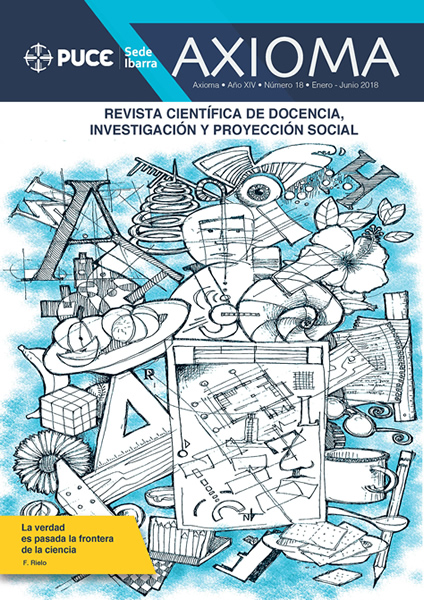Design of a device for passive knee auto-rehabilitation
Main Article Content
Abstract
During 2016, 408,021 people with disabilities have been registered in Ecuador, from which 193,520 are physically handicapped and 9,895 of them have pathological damage in the knee, which evidences there is a high percentage of the population that needs knee rehabilitation, a problem that, in its first stage, might cause the patient is not be able to make any efforts on the knee.In order to treat this type of conditions, the use of various automated devices is common. Said devices are usually imported, which implies a high cost associated with the product. From this, it arises the need to make a conceptual design of a passive knee rehabilitation with a user’s input, composed of a simple geometry mechanism, built with materials found in the country and at the lowest possible cost. In this research, there is a hierarchical analysis of alternatives to select the one that complies globally with the aforementioned criteria and that allow to develop flexion and extension movements. It is also taken into account the aesthetic part and the needs of the product supported by the indications and the information collected with physiotherapists and oriented to the self-rehabilitation of the adult population of Ecuador. The results have shown that is possible to materialize a design which combines a cinematic analysis and resistance of materials using CAD-CAE programs that serve to completely define the geometry and materials of the device based on a mechanism of four bars, which allows flexion-extension movements of 170º to 90º that correspond to the knee rehabilitation phases. Also, it incorporates exterior forms with a chromatic set with colors that awaken and stimulate the activity of rehabilitation, these colors harmonize design with the orientation of the product.
Downloads
Article Details
Con la finalidad de contar con un tipo de licencia más abierta en el espectro que ofrece Creative Commons, a partir de diciembre de 2022 desde el número 27, AXIOMA asume la Licencia Creative Commons 4.0 de Reconocimiento-NoComercial-CompartirIgual 4.0(CC BY-NC-SA 4.0). Tanto el sitio web como los artículos en sus diferentes formatos, reflejan esta información.
![]()
Hasta el mes de noviembre de 2022 con el número 26, la revista AXIOMA asumió una Licencia Creative Commons Atribución-NoComercial-SinDerivadas 4.0 Internacional (CC BY-NC-ND 4.0). Los artículos contenidos en cada número hasta el 26, cuentan con esta licencia y su descripción se conserva en el portal de nuestra revista.
Atribución-NoComercial-SinDerivadas
CC BY-NC-ND
AXIOMA- Revista Científica de Investigación, Docencia y Proyección Social
References
Branch, T, Cunningham,T., Dittmar, E., y Jacobs, C. (2016). Robotic Knee Testing Device, Subjective Patient Input Device and Method for using same. United States. US2016338649 (A1). Patente Internacional.
CONADIS. (2016). Consejo Nacional para la Igualdad de Discapacidades. Informe Estadístico de Personas con Discapacidad. Quito, Ecuador: Ministerio de Salud Pública de Ecuador. Recuperado de http://www.consejo discapacidades. gob.ec/
Ding, X., Yang, T., Qian, F., Ding, J., y Zhao, Z. (2016). Knee joint flexion function rehabilitation exercise device. China. CN20161 308652.Patente Internacional.
Guzmán Valdivia, C. H., Blanco Ortega, A., Oliver Salazar, M. A., y Azcaray Rivera,H. R. (2014). Modelado y Simulación de un Robot Terapéutico para la Rehabilitación
Hall J. (2017). Knee Rehabilitation Device. United States. US. 2017027799. Promotus Llc. Patente Internacional.
INEC. (2016). Instituto Nacional de Estadísticas y Censos. Anuario de Estadísticas Hospitalarias: Egresos y Camas. Quito, Ecuador: Dirección de estadísticas sociodemográficas. Recuperado de: http://www.ecuador en cifras.gob.ec/camas-y-egresos-hospitalarios/
Rashid, K. (2017). Karimanifesto Recuperado de http://www.karimrashid.com/karimanifesto
Romero, M. (2012). Diseño y construcción de una ortesis de rodilla, destinada a la rehabilitación automatizada de la extremidad inferior. Tesis de pregrado. Universidad Politécnica Salesiana. Cuenca, Ecuador
Schmitt, C., y Métrailler, P. (2004). The Motion Makerâ„¢: a rehabilitation system combining an orthosis with closed-loop electrical muscle stimulation. En 8th Vienna International Workshop on Functional Electrical Stimulation, Viena, Austria.
Swortec. (2017). MotionMakerâ„¢. Recuperado de http://www.swortec.ch/index.php/products/motionmaker
Tian, F., Hefzy, M. S., y Elahinia, M. (2015). State of the Art Review of Knee–Ankle–Foot Orthoses. Annals of biomedical engineering, (43)(2), 427-441.
Umchid, S., y Taraphongphan, P. (2016). Design and development of a smart continuous passive motion device for knee rehabilitation. In Biomedical Engineering International Conference (BMEiCON), 2016 9th (pp. 1-5). IEEE.
Vergara, M., Segnini, J., Santacruz, P., y Kastillo, A. (2017). Diseño de un bipedestador modular pediátrico que incorpora el arte precolombino Ecuatoriano. Vergara, M., Díaz, M., Rivas, F. y Restrepo, M. Diseño de Equipos de Rehabilitación y Órtesis.
Vergara, M., Segnini, J., Provenzano, S., Chagna, A., y Diez, J. (2017). Diseño de un Dispositivo para Autorehabilitación Pasiva de Rodilla no Supervisada. Vergara, M., Díaz, M., Rivas, F. y Restrepo, M. Diseño de Equipos de Rehabilitación y Órtesis.
Wilkening, A., Baiden, D., y Ivlev, O. (2012). Assistive acting movement therapy devices with pneumatic rotary-type soft actuators. Biomedizinische Technik/Biomedical Engineering, (57)(6), 445-456
Xiaoning, L., Jianping, L., Zhongsheng, S., Yan, T., y Gang, Y. (2010). Flexible active and passive knee-joint rehabilitation training device. China. CN 201010146319. Univ. Nanjing Science & Tech. Patente Internacional

